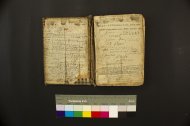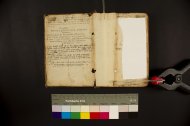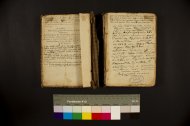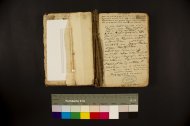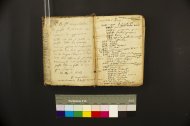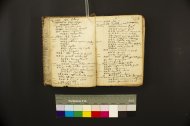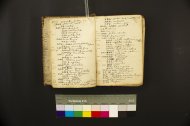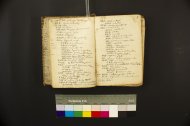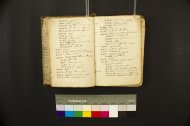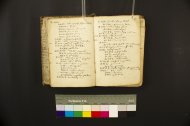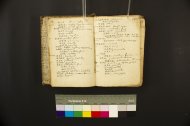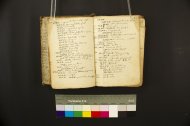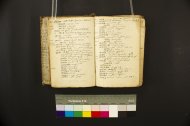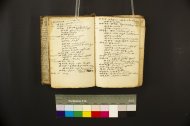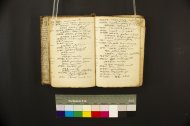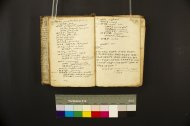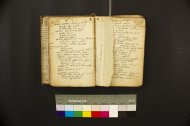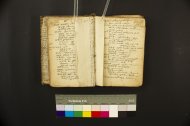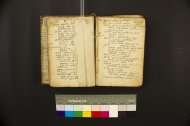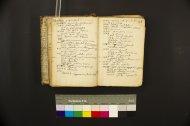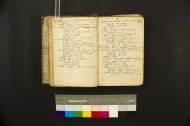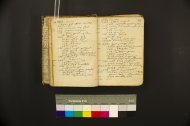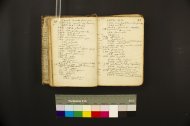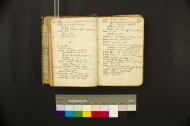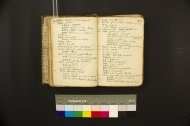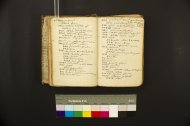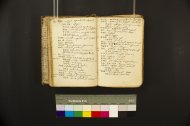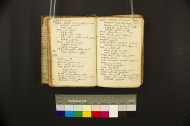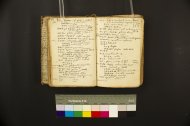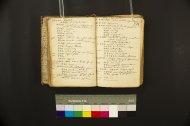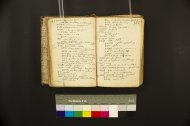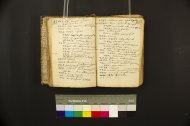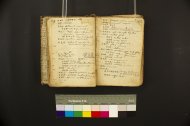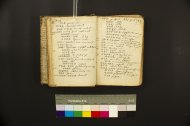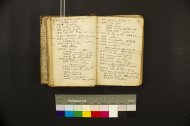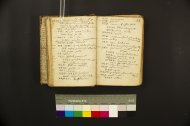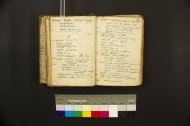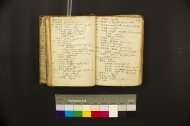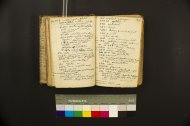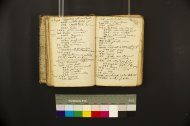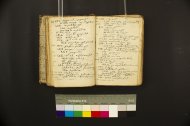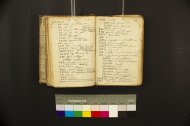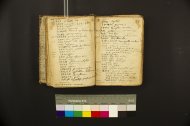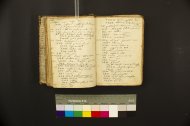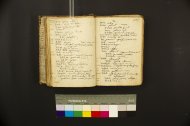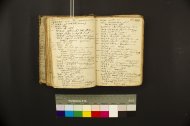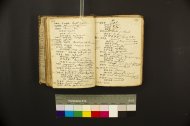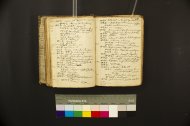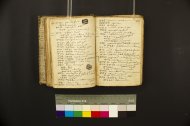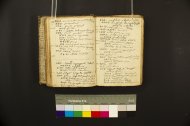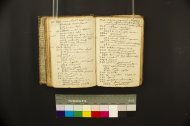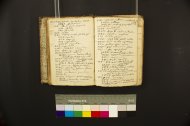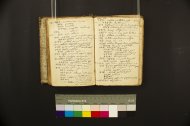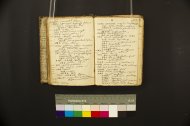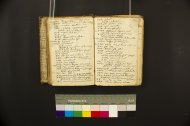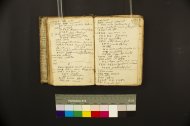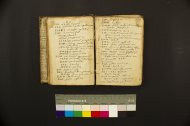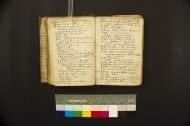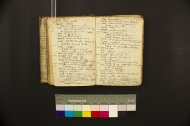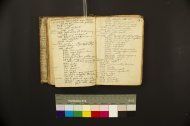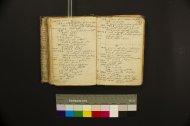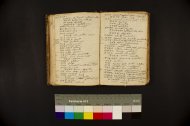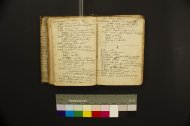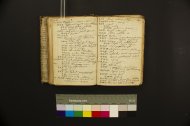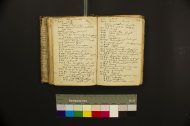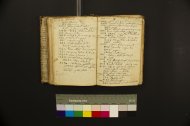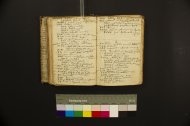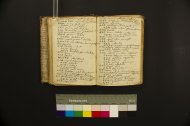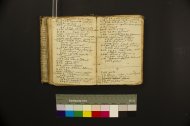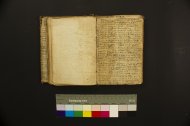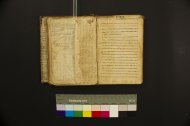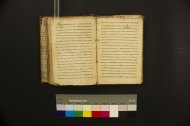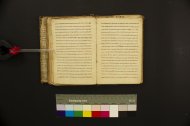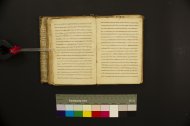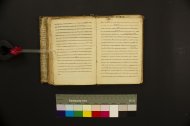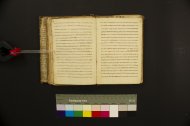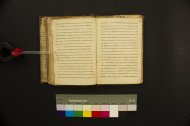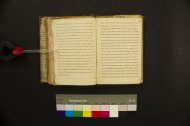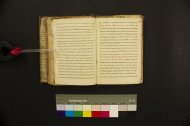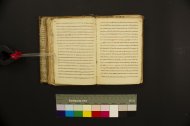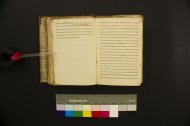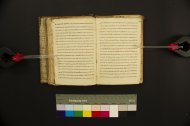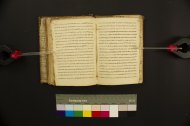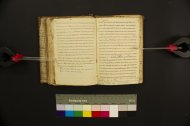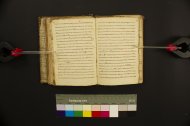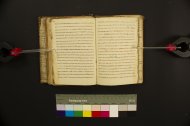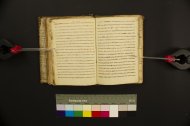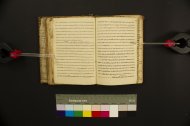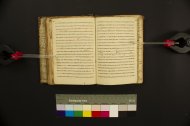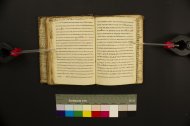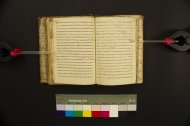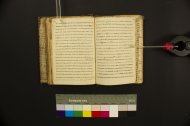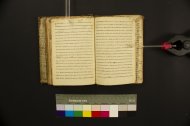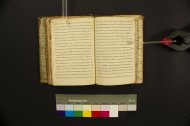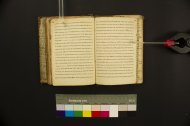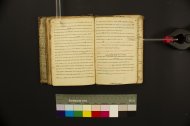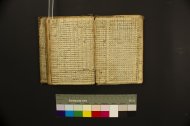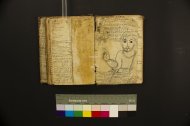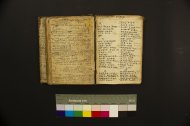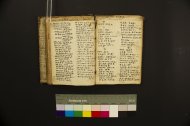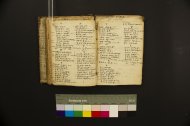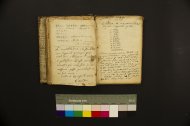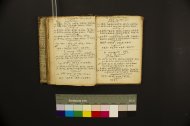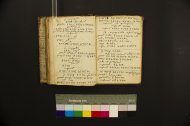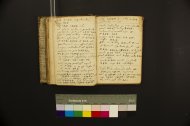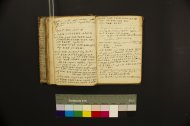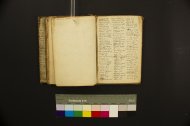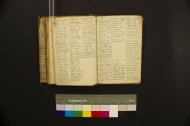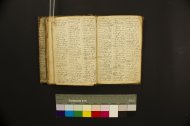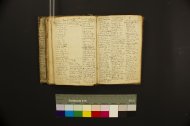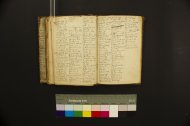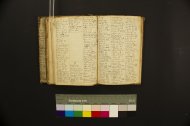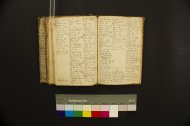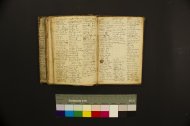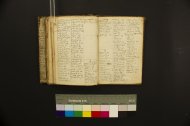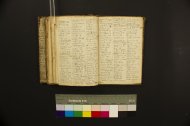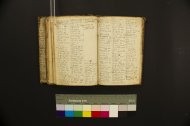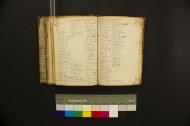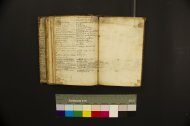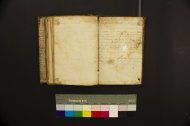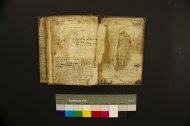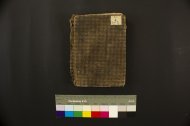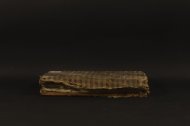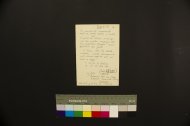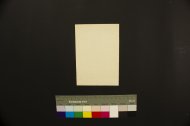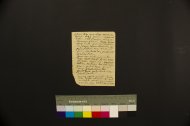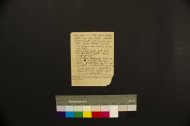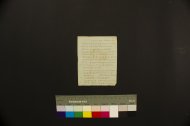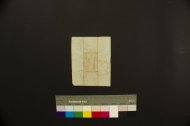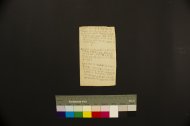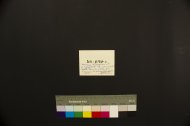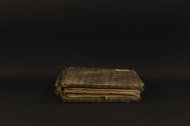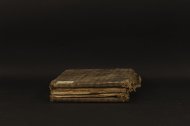|
Shelfmark |
SGI 247 |
|
Owning institution |
Società Geografica Italiana, Rome |
|
Typology |
Codex The manuscript is composite: it consists of 4 codicological units: I (ff. 1–85), II (ff. 86–119), III (ff. 120–123), IV (ff. 124–145). |
|
Copying date |
Mid-19th century |
|
Title |
Gǝʿǝz-Latin dictionary and grammatical sketch by P. Giusto d’Urbino |
|
Subject |
Aethiopica, Lexicon, Grammar |
|
Language |
Italian, Latin, French, Gǝʿǝz, other Ethiopian languages |
|
Outer size (included the binding) |
162 x 115 x 24 mm |
|
Outer size of the textblock |
160 x 113 x 14 mm |
|
Number of folia |
145 |
|
Binding |
Two wooden boards covered with a checked textile. Two sewing stations. |
|
Sewing |
Five S-twisted threads (each is Z-twisted) of vegetal origin. |
|
Sewing pattern |
Bozzacchi A |
|
Slip case |
– |
|
State of preservation of the binding |
Poor. |
|
Provenance and history |
Unit I was written by P. Giusto da Urbino (1814–1856) in 1849, with some notes drawn up in the following years, up to April 1853. P. Giusto had arrived in Ethiopia in 1846 following Cardinal Guglielmo Massaja. According to the colophon, Unit II was written by a certain Abba Filkǝsyus between 3 and 12 March 1851. Unit II was sewn to the other units probably soon after its completion. Unit III is a quire of unknown origin, which was sewn together with the other units at some time before 1853. Since Unit III accommodates a note written in April 1853 by P. Giusto da Urbino referring to the following Unit IV, at that time the two units were necessarily bound together. Unit IV was written in 1849 like Unit I, with some notes drawn up in the following years up to April 1853. All units were bound together by April 1853. Da Urbino presumably brought this book with him in Egypt after his expulsion from Ethiopia in May 1855. After da Urbino’s death, in November 1856, the manuscript came into possession of someone who drawn up some biographical notes in French, certainly after 1856 (f. 3r). He possibly was also the author of the notes written in June 1859 (front guardleaf, f. 86r) and in June 1867 (f. 87r). Finally, the manuscript came into possession of the Società Geografica Italiana at some time before 1930, because Gabrieli refers to it in his Manoscritti e carte orientali nelle biblioteche e negli archivi d'Italia: dati statistici e bibliografici delle collezioni, loro storia e catalogazione, 1930. The manuscript is mentioned in Silvio Zanutto’s Bibliografia etiopica (1932). |
Unit I (ff. 1–85)
|
Folia |
Ff. 1–85 |
|
Copying date |
1849 (cp. ff. 3v, 4r) |
|
Short description of the content |
Ff. 4r– 85r: Gǝʿǝz-Latin dictionary, compiled by P. Giusto da Urbino. The dictionary follows the fidäl alphabetical order: ሀ (ff. 4r–4v), ለ (ff. 5r–7v), ሐ (ff. 8r–12v), መ (ff. 13r–19r), ሠ (ff. 19v, 22r–23v), ረ (ff. 24r–26v), ሰ (ff. 26v–32v), ቀ (ff. 32v–37v), በ (ff. 37v–42v), ተ (ff. 42v–44v), ኀ (ff. 44v–46v), ነ (ff. 47r–51r), አ (ff. 51v–56v), ከ (ff. 57r–59v), ወ (ff. 60r–62v), ዐ (ff. 62v–66v), ዘ (ff. 67r–68v), የ (ff. 68v–69r), ደ (ff. 69v–72r), ገ (ff. 72r–76r), ጠ (ff. 76r–78r), ጰ (f. 78r), ጸ (ff. 78v–81v), ፀ (ff. 82r–83r), ፈ (ff. 83r–85r), ፐ (f. 85r). Sometimes Latin meanings are followed by Italian equivalents in brackets. This dictionary constitutes the first attempt to systematize the Gǝʿǝz lexicographic material collected by P. Giusto during his stay in Ethiopia. The content of this dictionary is still unpublished, unlike that of the other two handwritten by P. Giusto and kept in MSS Roma, BNCR Or. 134, and Paris, BnF Éth. Abb. 217). |
|
Writing material |
Paper |
|
Blank folia |
Ff. 2r–2v, 21r–21v, 85v |
|
Quires |
10 |
|
Quire marks |
Quire marks are indicated with Ethiopic numerals in the upper inner corner of the first folio of each quire. |
|
Layout |
1 column |
|
Number of lines per column |
25–30 |
|
Ruling |
The manuscript is unruled. Two vertical lines have been executed in pencil in each folio to accommodate the Gǝʿǝz wordlist and the Latin equivalents in each column. |
|
Ruling pattern |
– |
|
Scribe |
P. Giusto da Urbino |
|
Colophon |
– |
|
Additional notes |
Front guardleaf: various writings in fidäl and Latin script, among which “Die 12 Jun. An. 1859” (?). F. 1r: ስብሐት፡ ለእግዚአብሔር፡ ፈጣሬ፡ ሰማይ፡ ወም<ድር፡> ስብሐት፡ ለእግዚአብሔር፡ ፈጣሬ፡ ሰማይ፡ ወምድር፡ ወኵ<ሉ፡>, “France Caesar MDCLXVI Fetina Fae France / Sanctus Perché questa Traduzione”, “ሶበ፡ cum dum illico postquam quamvis si non, confestim”. F. 1v: Title written in Latin. “Locutio, nomen, pronomen, verbum, nomen declinatur in numeros, et casus, numerus singularis vel pluralis, Casus 6, nominativus, genitivus, dativus, accusativus, vocativus, ablatives. Verbum”. F. 1v: Text in fidäl in an unidentified language. Incipit: ኖኒኾ፡ ሲማጅ፡ ቤቶቶ፡ ነሽጎ፡ ቅዱሴባ፡ ነታቲ፡ ወቡ።. The text has numerous corrections in pale black ink. F. 3r: Text written in fidäl in an unidentified language. Incipit: ታየር፡ ኒቦ፡ ታሲማቃ፡ ታኻሊቶቾ ነስ፡ ሻጊዲዮ፡ ሴጣኖቸ፡ ታኪሲቶቾ፡ ክስታኖች፡ ታቱኒቶቾ፡ ነኹኖ፤ ኻናች፡ ታኼሲቶቾ፡ … F. 3r: Short biographical note on P. Giusto da Urbino, written in French by someone who saw him in Egypt in 1855. The note was written after 1856. “Le pére Just d’Urbino vint en Abyssinie avec Mgr Massaja V. ap. des Gallas en 1846 envoyé par le Pape Grégoire XVI peu de jours avant la mort. Il resida en Abyssinia à Bethlem à Devra Tabor. Fut chassé en 1853 par Negus Theoderos et par Abba Salama. Se rendit au Caire ou je l’ai vu en 1855. Refusa d’être coadjuteur Massaja. Lors de son retour en Abyssinie en 1856 il mourut de dysenterie à Khartum dans le Sennââr en 7 [….] 1856 à la mission autrichienne. Requiescat in pace”. F. 3v: Note written in Italian by Giusto d’Urbino: “N.B. Il compilatore di questo dizionario non intende di approvare tutto ciò che è scritto in questo libro. Lo riconosce come un primo ed imperfetto prodotto dei suoi primi studi di lingua etiopica. E desidera che nessuno si prevalga ciecamente dell’autorità di questo libro in fatto di lingua etiopica. 14 Aprile 1853. Il compilatore”. F. 4r: Ownership note, written in Gǝʿǝz in black ink in the upper outer corner of the folio: መጽሐፍ፡ ዘአባ፡ ዮስጦስ፡. It indicates that the book belongs to Abba Yosṭos, i.e. Padre Giusto (da Urbino). F. 4r: note written in Italian by Giusto d’Urbino in the upper margin of the folio. It indicates the date of writing of the dictionary: “compilato il 1849”. F. 19r: a text in Gǝʿǝz has been added in the main hand. Incipit: ድኅረ፡ ኀለፈ፡ ክረምት፡ ወገብአ፡ ዝናም። አንተ፡ አስተርአይከ፡ እግዚኦ፡ ጽጌያተ፡ ገዳም። አፈወ፡ ሃይማኖት፡ ነዓልድ፡ ምስለ፡ ፍሬ፡ ምግባር፡ ጥዐም።. |
|
Decoration |
– |
|
State of preservation of the textblock |
Poor. |
Unit II (ff. 86–119)
|
Folia |
Ff. 86–119 |
|
Copying date |
1851 (cp. f. 86r) |
|
Short description of the content |
Ff. 88r–116r: Säwasǝw (Gǝʿǝz-Amharic lexical and grammatical treatise) Incipit: በስመ፡ አብ፡ … ንቀድም፡ በረድኤተ፡ እግዚእነ፡ ኢየሱስ፡ ክርስቶስ። ጽሒፈ፡ ሰዋስው፡ ያጽንዓነ፡ እምድካም፡ ወያንቅሐነ፡ እምንዋም። ወሰላመ፡ እግዚአብሔር፡ የሃሉ፡ ምስለ፡ ፍቁሩ፡ አባ፡ ፊልክስዩስ፡ ለዓለመ፡ ዓለም።. 1) Ff. 88r–92v: Lexical chapter, divided into 15 thematic sections, called kǝfl. Chapters 12–15 are unnumbered. Incipit: ሰዋስው፡ ማለት፡ መሰላል፡ መሸጋገሪያም፡ ይኾናል። ምስር፡ ማለት፡ ምድር፡ ብዙውን፡ አምዳር። ደብር፡ ተራራ፡ ብዙውን፡ አድባር። ወግር፡ ማ፡ ኮረፍታ፡ ብዙውን፡ አውግር።. 2) Ff. 93r–95v: Morphological chapter on the conjugation of the verb ይቤ፡/አለ፡ (“to say”), divided into 11 sections, called kǝfl. 3) Ff. 96r–99v: Morphological chapter on the conjugation of the verb ገብረ፡/አደረገ፡ (“to do”), divided into 11 sections, called kǝfl. 4) Ff. 100r–103v: Morphological chapter on the conjugation of the verb አእመረ፡/አወቀ፡ (“to know”), divided into 11 sections, called kǝfl. 5) Ff. 104r–116r: Morphological chapter on pronouns, adjectives, and prepositions, divided into 44 sections, called kǝfl. Sections 8–44 are unnumbered. 6) F. 116r: Colophon. Ff. 116v–117r: calendar table of the main religious feasts of the years 7347–7376 of the world (i.e. 1854/55–1883/84 CE). |
|
Writing material |
Paper |
|
Blank folia |
– |
|
Quires |
1 |
|
Quire marks |
– |
|
Layout |
1 column |
|
Number of lines per column |
20 |
|
Ruling |
The manuscript is unruled. |
|
Ruling pattern |
– |
|
Scribe |
Abba Filkǝsyus |
|
Colophon |
F. 116r: ዝንቱ፡ መጽሐፍ፡ ዘአጽሐፎ፡ አቡነ፡ ፊልክስዩስ፡ በእንተ፡ ፍቅረ፡ እኁሁ፡ አቡነ፡ ቄሣር፡ ዘይሰመይ፡ ገብረ፡ ማርያም፡ ተወጥነ፡ በ፸፻ወ፫፻፵ወ፫ዘመነ፡ ሉቃስ፡ አመ፡ ፳ወ፭ለየካቲት፡ በዕለተ፡ ሰኑይ፡ ወተፈጸመ፡ አመ፡ ፬ለመጋቢት፡ በዕለተ፡ ረቡዕ፡ ጊዜ፡ ፫ሰዓት፡ በኃይለ፡ እግዚአብሔር፡ ለዓለመ፡ ዓለም፡ አሜን፡ ወአሜን፡ ለይኩን፡ ለይኩን። The colophon is written in the main hand in brown and red ink; yet the year has been inserted interlineally in black ink. It states that the writing began on 25 Yäkkatit of the year 7343 of the world (i.e. 3 March 1851 CE) and was completed on 4 Mäggabit (i.e. 12 March 1851 CE). The colophon also mentions Abba Filkǝsyus and his brother Abba Qeśar, also said Gäbrä Maryam. |
|
Additional notes |
F. 86r: Notes written in Latin alphabet containing words and morphological terminations of an unidentified Ethiopian language in transcription. The notes are dated to 9 June 1859 (?) and 11–12 June (probably 1859). F. 86v: Unclear text written in Amharic: Incipit: ፩ቁርጫሺ፡ እስከ፡ ፫ (ጨቦ፡) ቤተ፡ ክርስ፡ ብዙ፡ ፪ወንጭ፡. F. 87r–87v: Note written vertically and almost entirely illegible due to faded ink, especially on f. 87r. The text is in an unknown Ethiopian language transcribed in Latin script. The date “2 junii 1867” is legible on f. 87r. F. 103v–104r: Notes written in Latin, Gǝʿǝz, and Amharic, in black ink, in the lower margins of the folios. The notes were in all likelihood penned by P. Giusto da Urbino and are of grammatical content. Text on f. 103v (the Latin word is written above the text in fidäl): “quis መኑ። ብ፡ ማን። quem መነ፡ ብ፡ ማነን። እለ፡ መኑ፡ ብ፡ እለ፡ ማን፡ quia ምንት፡ ብ፡ ምን። ምንተ፡ ብ፡ ምንን።”. Text on f. 104r: “Pronomi primitive ፰ Ego, Tu, Sui, Ille, Ipse, Iste, Hic, Ii (et Idem). Pronomi derivativi ብ፡ ይቅርብና፡ የሩቅ፡ ዝርዝር፡ ፯፡ meus, Tuus, Suus, Noster, Vester, Nostros, Vestros”. F. 118vb: illegible writing in pencil. F. 117va: index of the previous Säwasǝw, written in Gǝʿǝz in black pen. F. 117v, 119r–119v: Lexical notes and wordlist from an unidentified Ethiopian language, written in black pen in Latin script. The text is entirely written upside down from f. 119v to f. 117r, except ca. 15 lines in the upper margin of f. 119r. |
|
Decoration |
F. 86v: drawing in pencil of a human face wearing a crown. Notes in pen and pencil are written over and around the drawing. F. 119r: drawing in pencil and black pen of Jesus Christ and an angel. Notes in black pen are written over and around the drawing. |
|
State of preservation of the textblock |
Poor. |
Unit III (ff. 120–123)
|
Folia |
Ff. 120–123 |
|
Copying date |
Before 1853 (cp. f. 123v) |
|
Short description of the content |
F. 120ra–123rb: Gǝʿǝz-Amharic wordlist. The dictionary follows the alphabetical order: ሀ (f. 120ra), ለ, ሐ, መ (f. 120rb), ሠ (f. 121ra), ረ, ሰ, ቀ (f. 121rb), በ (f. 121va), ተ, ኀ (f. 121vb), ነ, አ (f. 122ra), ከ (f. 122va), ወ, ዐ, ዘ (f. 122vb), የ, ደ, ገ (f. 123ra), ጠ (f. 123ra), ጰ, ጸ, ፀ (f. 123rb), ፈ. The wordlist also accommodates Gǝʿǝz entries, with their respective meaning in Latin, added at a later time by P. Giusto. |
|
Writing material |
Paper |
|
Blank folia |
– |
|
Quires |
1 |
|
Quire marks |
– |
|
Layout |
2 columns |
|
Number of lines per column |
ca. 25–30 |
|
Ruling |
The manuscript is unruled. |
|
Ruling pattern |
– |
|
Scribe |
Most probably P. Giusto da Urbino |
|
Colophon |
– |
|
Additional notes |
F. 123v: Note written in Italian by Giusto d’Urbino: “L’inesattitudine e la sterilità dei seguenti principii grammaticali obbligano l’autore a protestare ch’egli non li riconosce più come suoi, e che nessuno possa prevalersene in suo nome. Dato il14 Aprile 1853. L’autore”. The note refers to the contents of the following Unit IV. |
|
Decoration |
– |
|
State of preservation of the textblock |
Mediocre. |
Unit IV (ff. 124–145)
|
Folia |
Ff. 124–145 |
|
Short description of the content |
Ff. 124r–130r: “De verbis”, grammatical sketch of the Gǝʿǝz verbal morphology, written in Latin by Giusto da Urbino. The sketch comprises sections for the following conjugations 1. gäbrä (f. 124v), 2. gäbärä, 3. gäbbärä (f. 125r), 4. gabärä, 5. agbärä (f. 125v), 6. agäbbärä, 7. tägäbrä, 8. tägäbbärä (f. 126r) 9. tägabärä, 10. astägäbrä, “verba gutturalia” (f. 126v), “verba defectiva” (f. 127r), “de quadriliteris” (f. 129r), “quinquelitera” (f. 129v), “anomala”, “impersonalia” (f. 130r). On f. 124r, a note written in Italian by Giusto d’Urbino in the upper margin of the folio indicates the date of writing: “scritto nel 1849”. The grammatical sketch is a first attempt by P. Giusto (later disavowed by the same author, cp. f. 123v) to provide a systematic description of the Gǝʿǝz verbal tenses and conjugations. Ff. 131ra–143rb: index of the Latin meanings of the Gǝʿǝz-Latin dictionary forming Unit I. Numbers next to each entry refer to page numbers assigned by da Urbino. |
|
Writing material |
Paper |
|
Blank folia |
Ff. 130v, 144r–144v. |
|
Quires |
2 |
|
Quire marks |
– |
|
Layout |
1) Ff. 124r–130r: 1 column; 2) Ff. 131ra–143r: 3 columns; 3) F. 143v: 2 columns. |
|
Number of lines per column |
ca. 21–38 |
|
Ruling |
The manuscript is unruled. Four vertical lines have been executed in pencil on ff. 131r–143r as to obtain three columns for indexing the Latin entries. |
|
Ruling pattern |
– |
|
Scribe |
P. Giusto da Urbino |
|
Colophon |
– |
|
Additional notes |
F. 143v: wordlist in Amharic, written in pale brown ink on 2 columns. F. 145r: note written in pencil in Italian (?), almost entirely illegible. F. 145r: various writings in fidäl and Latin, written in various directions in black and brown ink. Among these: “ቀናዪ፡ መላኪ፡ ማር፡ እግዚእ፡ Dominus Dominus Dominus”, “F. Justo d’Urbino ex Or. FF. Min. Cap”. An Amharic note of difficult interpretation is written upside down in the lower half of the folio; the text has numerous corrections and is entirely crossed out. The note seemingly continues on the upper margin of the end guardleaf. |
|
Decoration |
– |
|
State of preservation of the textblock |
Poor. |
The manuscript also accommodates 4 loose paper leaves of different origin and size:
Leaf A: It hosts on the recto side a note written in Italian by a certain P. Antonino Rosso da Lanza, archivist capuchin, in Turin. The note informs on the authorship of the book: “[Catal. 247] Il presente vol. manoscritto dato di incerto autore è invece del P. Giusto da Urbino, O.F.M. Cap., uno dei quattro compagni del Mons. Guglielmo Massaja, Vicario Apostolico dei Galla. L’Autore, oltre che dalla scrittura, risulta chiaramente nell’ultima pagina del ms. dove si legge F. Justo d’Urbino ex Or. FF. Min. Cap. (inv 66320). In fede, P. Antonino Rosso da Lanza Archivista Provinciale P.F.M. Cap., Torino (10131). Monte dei Cappuccini”.
Leaf B: Small-sized leaf. It hosts on both sides a text, written in brown ink in an unidentified Ethiopian language transcribed in Latin script. It was probably written by P. Giusto da Urbino in the mid-19th century.
Leaf C: Small-sized leaf. It hosts on the recto side the text of a letter, written in Gǝʿǝz and Amharic in pale brown ink. The letter is dated to 15 Ḫǝdar of an unspecified year. The text is the following: አ<መ>፲ወ፭ለሕዳር፡ እምጫላ፡ ትብ<…> ኀበ፡ አቡየ፡ አባ፡ ኃይለ፡ ሚ<ካኤል>፡ ሰላም፡ ለከ፡ አቡየ፡ ወፍቁርየ፡ ወሰላመ፡ እግዚአብሔር፡ የሀሉ፡ ምስሌከ፡ ወምስለ፡ አኃዊነ፡ ኵሎሙ። ንሴብሖ፡ ለእግዚአብሔር፡ ለዘገብረ፡ ዘንተ፡ አቢየ፡ መንክራተ፡ በእንተ፡ ዘወጽዓ፡ እምሰናስለ፡ ዝዓለም፡ ዝንቱ፡ አቢየ፡ ሐዋርያ፡ ወምሉእ፡ ጥበብ፡ ዘይረብሐነ፡ ለብዙኅ፡ ነገር። ይኤምኁለ፡ ደቂቅከ፡ ኵሎሙ፡ እለ፡ ኀለዉ፡ በዝየ፡ ዘንስዑ፡ እምኔከ፡ ጸፋ፡ መንፈስ፡ ቅዱስ። አባቴ፡ ሆይ፡ ለጌታው፡ ተናግረው፡ ሞፍቲ፡ ይሰድዱልኝ፡ ከዚያች፡ ትንሽ፡ መጻፍ፡ ጋራ። ፪ኛ፡ የዕሁድ፡ ቍጥር፡ ተሰስቶኛልና፡ ያስታውቁኝ፡ ደግሞ፡ አቢይ፡ ጾም፡ የካቲት፡ በገባ፡ በ፲፫ቀን፡ መስሎኛል፡ እውነት፡ ነዉን፡. On the verso side, the name of a certain Abbate Ḫaylu (abbreviated form of Ḫaylä Mi<kaʾel>) is written in the same ink by the same hand. The text was seemingly written by P. Giusto da Urbino himself to Abbate Ḫaylu.
Leaf D: Small-sized leaf. It hosts on both sides some rudimentary writings in Amharic.


